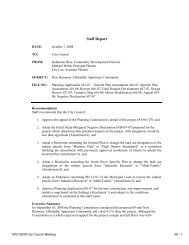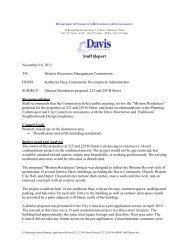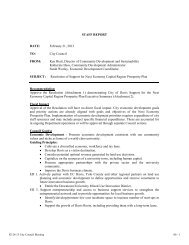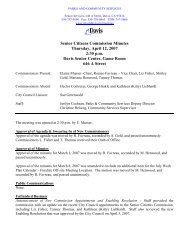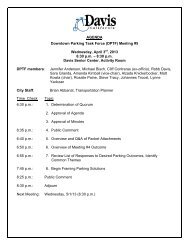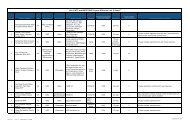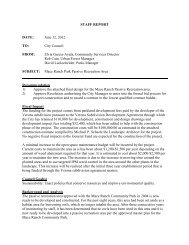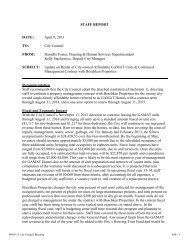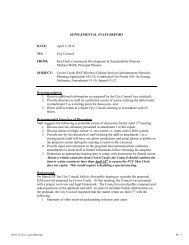10 Draft Integrated Waste Management Plan - City Council - City of ...
10 Draft Integrated Waste Management Plan - City Council - City of ...
10 Draft Integrated Waste Management Plan - City Council - City of ...
You also want an ePaper? Increase the reach of your titles
YUMPU automatically turns print PDFs into web optimized ePapers that Google loves.
2012 Davis <strong>Integrated</strong> <strong>Waste</strong> <strong>Management</strong> <strong>Plan</strong><br />
loaded, and any residential project where solid waste is collected and loaded in a location serving five or more<br />
living units.<br />
(2) The definition <strong>of</strong> development project only includes subdivisions or tracts <strong>of</strong> single-family detached<br />
homes if, within such subdivisions or tracts, there is an area where solid waste is collected and loaded in a<br />
communal location. In such instances, recycling areas as specified in this ordinance are only required to serve<br />
the needs <strong>of</strong> the living units which utilize the solid waste collection and loading area.<br />
Improvements means an addition made to property or to a facility which adds value to the property or facility,<br />
prolongs its useful life, or adapts it to new use. Improvements should be distinguished from repairs. Repairs<br />
keep facilities in good operating condition, do not materially add to the value <strong>of</strong> the facility, and do not<br />
substantially extend the life <strong>of</strong> the facility.<br />
Public facility includes, but is not limited to, buildings, structures and outdoor recreation areas owned by the<br />
city.<br />
Recycling area or areas for recycling means space allocated for collecting and loading <strong>of</strong> recyclable materials.<br />
Such areas shall have the ability to accommodate the appropriate receptacles for recyclable materials. For<br />
existing residential buildings or projects between five and nine living units, “recycling areas or areas for<br />
recycling” may mean, at the discretion <strong>of</strong> the planning and building department, curbside recycling. (Ord. 1765<br />
§ 1)<br />
32.03.020 General requirements.<br />
(a) Any new development project for which an application for a building permit is submitted on or after<br />
September 1, 1994, shall include adequate, accessible, and convenient areas for collecting and loading<br />
recyclable materials.<br />
(b) Any existing development project for which an application for a building permit is submitted on or after<br />
September 1, 1994, for modifications that add thirty percent or more to the existing floor area shall include<br />
adequate, accessible and convenient areas for collecting and loading recyclable materials. (Ord. 1765 § 1)<br />
32.03.030 Guidelines for all development projects.<br />
(a) The location, size, and design <strong>of</strong> the recycling areas shall be subject to the review and approval <strong>of</strong> the<br />
planning and building department in consultation with the fire department and the public works department.<br />
(b) Areas for recycling shall be adequate in capacity, number, and distribution to serve the development where<br />
the project occurs.<br />
(c) Dimensions <strong>of</strong> the recycling areas shall accommodate receptacles sufficient to meet the recycling needs <strong>of</strong><br />
the development project.<br />
(d) An adequate number <strong>of</strong> bins or containers to allow for the collection and loading <strong>of</strong> recyclable materials<br />
generated by the development should be located within the recycling areas <strong>of</strong> development projects.<br />
(e) Any recycling areas shall be located so they are at least as accessible and convenient as the locations<br />
where solid waste is collected and loaded. Whenever feasible, areas for collecting and loading recyclable<br />
materials should be within or adjacent to the trash collection areas.<br />
(f) Recycling areas should be designed to be architecturally compatible with nearby structures and with the<br />
existing topography and vegetation in accordance with city standards and shall comply with all applicable<br />
federal, state or local laws.<br />
DRAFT<br />
(g) Recycling areas or the bins or containers placed therein must provide protection against adverse<br />
environmental conditions which might render the collected materials unmarketable.<br />
(h) The city recommends, but does not require, that applicants consider security to prevent the theft <strong>of</strong><br />
recycling materials by unauthorized persons, while allowing authorized persons access for disposal <strong>of</strong> materials.<br />
(Ord. 1765 § 1)<br />
32.03.040 Additional guidelines for multifamily development projects.<br />
Page | A-112



